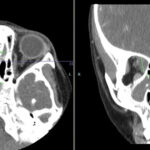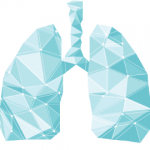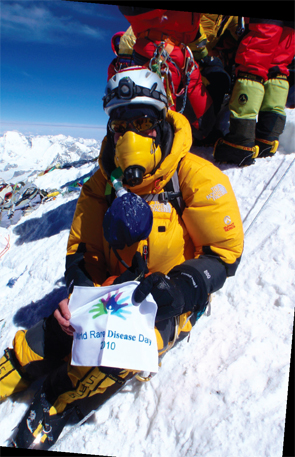
On the summit of Mt.
Everest, Ms. Abbott displays a banner for the National Organization of Rare Disorders.
On May 23, 2010, Cindy Abbott was standing on top of the world. She had spent the past 51 days climbing Mount Everest, the tallest mountain in the world, and had finally reached the summit.
“I was very anxious to get off and get back down,” she says, adding that the summit is about the size of a pool table. “Most of the accidents happen on the way down. So I sat down, took my medication, got my shot holding the National Organization of Rare Disorders (NORD) banner, put my glove back on and headed right down. The storm hit when we started down.”
At this high altitude, known as the Death Zone, the oxygen level is so low that the body begins to shut down. Even the most acclimatized mountain climbers can’t spend more than 48 hours above 26,000 feet. (The bottom of the Earth’s stratosphere is 33,000 feet.)
Under conditions with 40-mile-per-hour winds and sub-zero temperatures, both of Ms. Abbott’s corneas froze. For all practical purposes, she was blind, although she could distinguish between light and dark, which enabled her to differentiate rock from sky or snow. Her fingertips and cheeks were frostbitten.
Ms. Abbott and the other four climbers in her group used one rope to rappel down 3,000 feet to prevent them from plunging off the mountain’s edge.
“The storm lasted until we got down to Camp 4 and lasted through the night,” Ms. Abbott says, adding it took nearly seven hours to reach the camp. “I was the 40th American female to summit Mt. Everest. I was 51 years old.”
GPA Won’t Define Her

Dr. Dellaripa
Although impressive by any measure, that’s not Ms. Abbott’s biggest accomplishment. Hardly. Ms. Abbott suffers from granulomatosis with polyangiitis (GPA), a rare blood vessel disease that affects roughly three out of every 100,000 people, according to the American College of Rheumatology.1 GPA often attacks the sinuses, lungs and kidneys, and can lead to kidney failure.
Since her 2007 diagnosis, Ms. Abbott continues to defy the odds—and not just clinically. Although her condition has been stable for seven years, it has left her functionally blind in her left eye, caused a series of transient ischemic attacks and prompted multiple sinus and eye surgeries. However, she refuses to let the illness define her or limit her active lifestyle. She continues climbing mountains, and earlier this year, finished Alaska’s 1,000 mile Iditarod race. What motivates her? No one knows, not even Ms. Abbot, who claims she’s simply experiencing life.
Toughest Challenge of All
Although some research has been conducted on GPA, the cause is still unknown.
“There’s no specific proof that there’s a genetic link or specific environmental etiology that we’re aware of,” explains Paul Dellaripa, MD, who is a rheumatologist in the division of rheumatology at Brigham & Women’s Hospital in Boston and is also an associate professor of medicine at Harvard Medical School. “The main areas of the disease are the respiratory tract—all the way from the nose down to the lungs and the kidney.”
The disease is most prevalent among Caucasian men and women who are middle age or older, although cases in children have been noted, he says. Individuals with GPA may also experience peripheral neuropathy in their hands or feet, causing numbness or nerve pain that negatively affects their ability to care for themselves. In rare cases, he says it can also affect a person’s vision and hearing, resulting in blindness or hearing loss.
Treatment typically consists of administering a host of drugs that may include corticosteroids, rituximab, mycophenolate, methotrexate or cyclophosphamide, which is a chemotherapeutic agent. Now that more drugs are available, patients stand a much better chance of controlling, but not curing, their disease.
Still, he says many doctors have never seen a case of GPA. Patients with the condition often complain of respiratory problems, cough, sinus problems or earaches, and are typically given antibiotics, which don’t manage the root of the disease.
“Once the diagnosis is made, the physician really has to be on top of it, watching the kidneys and lung function very closely, and be very cognizant of recurring inflammation, flares and recurrence of the disease,” says Dr. Dellaripa. “You can have ongoing tissue damage and disease activity in patients at a very subtle level. You can miss it if you’re not watching.”
Ms. Abbott’s symptoms first appeared when she was in her mid-30s. She recalls her vision being distorted, blood in her urine, and giant bruises appearing on her legs after gently bumping into objects. An adjunct professor in health sciences at California State University, Fullerton, for the past 23 years, she says doctors repeatedly tested her kidneys and conducted other medical tests for 14 years, but couldn’t find anything wrong.
Then in August 2007, doctors at UCLA’s Jules Stein Eye Institute diagnosed her with a central retina vascular inclusion in her left eye, which made her functionally blind in that eye.
“That was the key that opened the door to unlock the answer to what was going on in my body,” Ms. Abbott says. “They said something else was going on and sent me across the street to a rheumatologist … . It took two months of testing and ruling things out to figure out a diagnosis.”
During that time, however, the disease was striking back. Besides losing half her sight, she was also hospitalized for transitory ischemic attacks.
“When diagnosed, I actually felt relief,” Ms. Abbott says, adding that she’s grateful the strokes didn’t kill her. “You think you’re going crazy, seeing dozens of doctors, and nobody can tell you what’s going on.”
She was prescribed CellCept and steroids to suppress her immune system and reduce inflammation, although her body couldn’t tolerate the steroids.
“The meds made me very sick,” she says, adding that she was 48 years old by then. “I couldn’t even sit in a chair… Every time I started feeling better, I took a higher dose.”
Still, Ms. Abbott is not the type to complain or seek pity, adds Kathy Koser, Ms. Abbott’s former boss who retired two years ago as associate dean of the College of Health and Human Development at California State University, Fullerton.
“The worse things happen to her, the stronger she gets,” says Ms. Koser, adding that Ms. Abbott’s favorite saying is by poet Vivian Greene: “Life isn’t about waiting for the storm to pass. It’s about learning to dance in the rain.”
Ms. Koser says Ms. Abbott is also a very private person and rarely mentions her disease to anyone, including students taking her personal health classes.
“Primarily, she teaches taking responsibility for your own health, how to live a better life, not just physically, but mentally, socially, emotionally,” says Ms. Koser. “She’s one of a kind—an unbelievable role model.”
Moving Up & Forward
Several months before her diagnosis, Ms. Abbott and her husband, Larry, also an active mountain climber, had planned on climbing Mt. Aconcagua, a mere 22,800-foot-high mountain in Argentina, in preparation for later climbing Mt. Everest. The couple had already booked their guide, climb and flight. Ms. Abbott was determined to let nothing—not even a rare disease or her doctors’ advice—stand in her way.
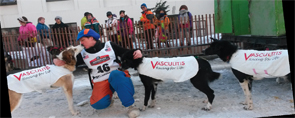
Ms. Abbott with her dog team at the start of the 2014 Iditarod.
Her rheumatologists didn’t know if the disease would flare up, leaving her stranded and possibly abandoned to die at 22,000 feet. They desperately tried to persuade her not to go.
“The doctors kept saying, ‘We don’t know what will happen at high altitudes,’” she says, explaining that high elevations could seriously affect her cardiovascular system. “My doctors were really unhappy because I wasn’t going to change my schedule. It became mind over matter.”
But everything went according to plan while climbing Mt. Aconcagua. Even Ms. Abbott’s disease appeared to cooperate. But when Ms. Abbott and the other climbers reached 19,000 feet, a raging storm approached. Its 80-mile-per-hour winds ripped apart their tents. The group was forced to abort the summit.
On the way down, Ms. Abbott tripped, tumbled roughly 100 feet, and heard and felt her left leg snap above her ankle. At this height, where a helicopter rescue was not an option, she had to make a decision.
“I could either sit down and die or spend the next five or six hours hiking down 5,000 feet to the base camp at 14,000 feet,” she says. She stood up and began hiking down, explaining that her boot acted as a splint for her swelled leg and her trekking poles as crutches. The following day, she was airlifted off the mountain by helicopter. When she returned home three days later, doctors implanted a metal plate in her leg.
If anything, that experience made her even more determined to stick to her training schedule. Ms. Abbott and her husband climbed another six mountains around the world, including Mt. Rainier, Mt. Elbrus and Peak Lenin, without incident or adverse effects from her disease.
Dogs, Snow & Sleep Deprivation
Several months after summiting Mt. Everest, an online acquaintance jokingly asked Ms. Abbott if she was now going to race in the Iditarod.
“I started checking it out,” says Ms. Abbott, adding that although she loves dogs, she had never driven a dogsled. By then, her doctors had surrendered and ceased their attempts to limit her activities.
She contacted one of the big mushers in Alaska, who was skeptical at first. “You live where?” he asked Ms. Abbott, who has lived in California since she was 13 years old. But after meeting him in the summer of 2010 at his kennel in Alaska, he agreed to train her.
“Like climbing, I took this 10 feet at a time,” Ms. Abbott says. “I learned how to run dogs, take care of them, break trails and navigate through the winter.”
However, she still had to qualify for the Iditarod by finishing three different, 300 mile races, each lasting nearly three days across the frozen Alaskan wilderness. Like many first-timers, she got lost and was forced to scratch in two races but did finish all three within two years and was approved by the panel of judges to enter the 2013 Iditarod.
Just before the race, she suffered a groin injury while training. She believed it was just a pulled muscle that would heal on its own and entered the race.
Two hours later, she slipped on some ice. She could barely lift her right leg. Still, “It wasn’t that bad,” she says. But by the eighth day, she could no longer stand. She scratched from the race on Day 10, approximately 370 miles from the finish line. Her diagnosis? A fractured pelvis.
Last year, terrible trail conditions prevented Ms. Abbott and 19 other mushers from finishing the Iditarod. There was no snow, which created very dangerous racing conditions. About 200 miles into the race, Ms. Abbott fell on a tree stump, injuring her right shoulder and had to scratch from the 2014 race.
But this year, luck was on her side. Ms. Abbott finished the race in less than 14 days. Since she came in last, she received the red lantern award for perseverance.
“Finishing the Iditarod was much more difficult than climbing Mt. Everest,” she says. “You get an hour or two of sleep here and there. Being responsible for those 16 dogs is huge. While they rest, you have to get their meals ready, check every paw, make sure they’re healthy and happy.”
Show & Tell
Through all of these extreme sports, her disease has not progressed an inch. She and her husband have since sold their house, temporarily to live in Tustin, Calif., and are planning to move within the next several years to Alaska so Ms. Abbott can continue racing.
She speaks at many conferences about her experiences and illness. She authored a self-published book, Reaching Beyond the Clouds: From Undiagnosed to Climbing Mt. Everest, and produced an 84-minute documentary about her adventures, disease and determination. She plans to enter it in the Tribeca and Sundance film festivals, before marketing it to TV or cable broadcasters.
As director of the Center for Rare Disease Therapies in Claremont, Calif., M. Ian Phillips, PhD, also hopes to show the documentary in February on Rare Disease Day, which is hosted by his organization. Dr. Phillips, also the faculty director for the post-baccalaureate pre-medical certificate program at Keck Graduate Institute of Applied Life Sciences, was interviewed about GPA for the documentary.
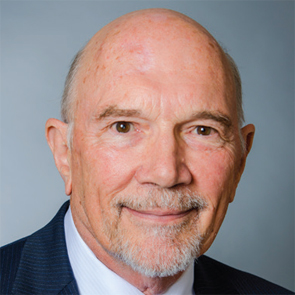
Dr. Phillips
“[Ms. Abbott] is somebody with a rare disease who has not let it stop her from doing fantastic things,” Dr. Phillips says. “In the end, it’s not about winning, it’s about doing it, finishing it. She’s an inspiration to people with diseases.”
Although Ms. Abbott says the only way she would climb Mt. Everest again was if she were handed at least $1 million, she dreams of her next adventure. But this one will take a lot more effort, energy and persuasion. She wants to take her NORD banner to the moon, which is why she named her documentary, “Banner on the Moon.”
“This isn’t a joke,” says Ms. Abbott. “I love living life, experiencing new things and challenging myself.”
Considering her background, anything is possible. Her illness is nothing more than an inconvenience.
Carol Patton is a freelance writer based in Las Vegas.
Reference
- Granulomatosis with polyangiitis (Wegener’s): Fast facts. The American College of Rheumatology.

